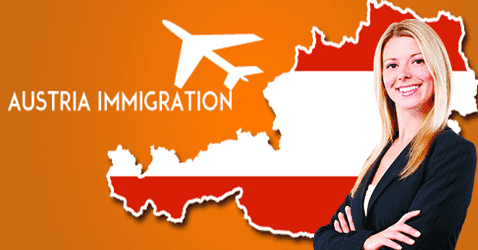Austria, as one of the wealthiest countries in the European Union, is a popular area for ex-pats to live and work. Vienna, in particular, is well linked, has a high average pay, and offers outstanding chances for culture, nightlife, and history. However, wherever you go in Austria, you’ll discover a bustling mix of cosmopolitan urban centres as well as spectacular natural resources and countryside to enjoy. If you’re considering relocating to Austria for work, Read this simple, no-nonsense, guide to getting an Austrian work visa
Regardless of the type of visa or permit, you’re attempting to obtain, you will be required to demonstrate that you have a sufficient source of income, health insurance, and a place to live. You must receive more than 70 points on the points-based scale outlined on the website of the immigration authorities to be considered a very highly qualified worker.
Do I Need an Austrian Work Visa?
Your first objective should be to determine whether or not you require a work permit at all. Permission may not be required in some circumstances, depending on your nationality and the role you will play. The majority of topics of immigration into Austria are covered in detail on the government’s migration portal.
European passport holders have the right to live and work in Austria, but if you plan to stay for more than three months, you must register your stay with the local authorities. It should also be mentioned that specific restrictions apply to Croatian citizens as part of the country’s transition to the EU.
These are subject to change, so if you are affected, you should review the most recent rules. If you are a third-country national, you will most likely require a visa or work permit to live and work in Austria.
What Is the Procedure for Obtaining an Austrian Work Visa?
The majority of migration to Austria is based on a flexible system known as the Red-White-Red Card, which is designed to award residence depending on the abilities of potential incoming workers and labour market needs in Austria.
Depending on your level of abilities and certifications, as well as the type of work you wish to do, there are numerous ways to qualify for a Red-White-Red Card. It may appear confusing at first, but the system is laid out quite simply online. The concept is also described in other languages on the Austrian business website.
You receive varying numbers of points under this system depending on your professional credentials, employment history, linguistic proficiency, and prior wage levels. The greatest place to start if you want to get better at languages is with a language app like busuu.
To be awarded a Red-White-Red Card of this type, you must already have a job lined up, albeit there is a Red-White-Red Card Plus alternative. This allows you to enter Austria to work without the need for a specific employer to sponsor you. This card is only provided in limited circumstances and is subject to strict requirements that are detailed online.
If you have already held a Red-White-Red Card for 10 of the previous 12 months, you can ‘upgrade’ to the ‘Plus’ version and have limitless labour market access. This implies you can work for any employer, not only the one listed on your ID card.
Workers in high-demand occupations can also apply for the Red-White-Red Card under the shortage occupations stream. In this situation, you must still take the points-based test, but you just need to score 50 points for your application to be considered.
Unfortunately, this method only covers a small number of roles, with 11 job fields defined as of March 2017. However, if you are designated a vital worker and are offered a job that earns more than the minimum monthly income, you may be eligible for the Red-White-Red Card through a distinct admission system.
The options are fully explained on the immigration authorities’ website. However, if you are unsure whether the method is ideal for your circumstances or if your case does not fall neatly into one of the categories listed online, it may be worthwhile to check with a local immigration consultant or agency.
Would You Like To Apply For This Jobs/Sponsorship?
Enter Your Email Address HERE & You Will Receive a Notification About Your Application. If it shows "Subscribed" CLICK HERE to follow on Telegram for updatesWhatever way you select to receive your work permit, you’ll need to submit the necessary paperwork to your local Austrian embassy, or if you’re already in Austria on a visa-free stay, you can apply to the local authorities there.
It should be reminded that the papers you require will be charged a cost. If you require a job seeker visa to cover your stay in Austria before you are eligible for your full work permit, you will be charged €100, plus an additional €120 for the Red-White-Red card.
What Documents Do I Need?
The particular documentation you’ll need may vary depending on the visa type you choose, as you’ll need to demonstrate how you meet the points criterion in each category. However, you should anticipate needing the following for all applications:
- Valid travel document
- Birth certificate
- Passport photo
- Evidence of planned accommodation
- Valid health insurance
- Proof of adequate financial support
Aside from that, you must give evidence for any claims you make as part of the computation of the points. For example, you’ll need to offer degree certificates, tax statements, work experience testimonies, and proof of language skills. The offered documents can be chosen from a list detailed on the website. Depending on the type of work you intend to conduct, you may be able to apply for an EU Blue Card.
The Blue Card paperwork, like the US Green Card, allows you to work in most EU member countries (excluding Denmark, Ireland and the UK). To be eligible for a Blue Card, you must be from a non-EU nation, highly skilled (usually a bachelor’s level university degree or five years of senior professional experience), and have a binding job offer or active work contract.
In the case of Austria, if you already have an EU Blue Card or meet the criteria, you may be awarded a Red-White-Red Plus Card, which has better terms than a standard work visa. This implies you may be able to come to Austria to hunt for a job without having a specific employer sponsor.
Member nations expedite the Blue Card application procedure, making it often faster than other types of work visa applications. It could potentially take up to three months. Even though you begin the application process online and with a single point of contact, the process may differ based on your circumstances. The Blue Card network has a nice website and provides candidates with assistance to help them comprehend the process.
Austrian Work Visas are Available For Part-time, Fixed-term, and Seasonal Employees.
Austria provides a special visa for seasonal workers in tourism, agriculture, and forestry. The quotas for seasonal worker visas are evaluated regularly, and a visa will be awarded only if the authorities are convinced that the task cannot be done by a local.
Visas are provided for a maximum of six weeks for persons travelling particularly to help with the agricultural harvest, with other seasonal labourers receiving visas for up to six months.
A temporary residency visa may be more appropriate for some other sorts of short-term work. If you are in Austria on a student visa, you are not allowed to work, but you can apply for a specific working permit if you do decide to work. Depending on the course, this permits you to work ten to twenty hours per week.
You might be eligible to apply for a working holiday visa, which enables you to work and study in Austria, depending on your age and country. The specifics are subject to change, but at the moment it includes residents of Taiwan, Hong Kong, Israel, New Zealand, and South Korea. Additionally, Canada and Austria have a unique agreement that permits some limited working holiday visas.
How Do I Get an Austrian Work Visa as an Entrepreneur?
To get a visa to come to Austria as an entrepreneur, you need to apply for a Red-White-Red card under the self-employed key worker route. The criteria required for this visa is that you bring sustained economic benefit to the area in which you’re working and are making a large investment or are creating employment.
Your application might also be considered if you can prove you’re bringing a certain level of expertise into the region which can not be found locally. You will also be asked to prove your intentions with a robust business plan, and evidence of agreements already made with local businesses if relevant, as well as all of the regular pack of documents needed for every visa application.
How Might My Spouse and Family Members Be Affected by My Austrian Work Visa?
If you have a Red-White-Red card or an EU Blue card, you can apply for a visa for your family to join you in Austria. This application applies to couples who are registered with same-sex partners as well as children under the age of 18. (including adopted or stepchildren).
A Red-White-Red Plus Card can be obtained for your spouse or partner, allowing them to look for and work in Austria without the need for advance employer sponsorship. Depending on the visa method you choose to obtain your Red-White-Red card, family members may be required to have a basic understanding of the German language. A language study tool like Busuu can provide you with results rapidly.
What Happens Now That I Have My Austrian Work Visa?
The migration authorities’ website has a wealth of information about settling into your new life in Austria. In some situations, you may be required to complete an integration course, which consists of one or two modules designed to strengthen your German language abilities and provide a basic introduction to living in Austria. The specific requirements vary depending on the type of visa you have, and there are some exceptions, such as for younger family members.
How Can I Move Money to Austria from my Bank Account Abroad?
To get the most out of your money in Austria, you’ll want to open a bank account in Austria, which you can do before you arrive. Once you send money either to or from Austria, consider using a money conversion service like Wise to avoid unfair exchange rates. There’s a small transparent fee, and when your money is converted from one currency to another you’ll get the real exchange rate – the same one you can find on Google. Not only that, but Wise receives and sends money via local bank transfers instead of internationally, further saving you money by cutting out hefty international transfer fees.
If your trip is short or opening a bank account in Austria isn’t an option, you can always withdraw money from your foreign account using an ATM there. Just keep in mind it’ll be more favourable to agree to be charged in the local currency, not your home currency.
Regardless of when you start your new job abroad, it should be fairly straightforward to get yourself a visa if you follow the right steps. The most important part is just to make sure to enjoy your new adventure.
or to start your own business, then you might need to get a permit to do so. In most cases, migration to Austria is regulated by a points-based system of visas known as the Red-White-Red Card. The various ways to get a Red-White-Red card can look complex on the face of it but is a relatively straightforward system once you grasp the basics.







zulumoses029**********, am here to work for you
Hi sir
zulumoses029**********